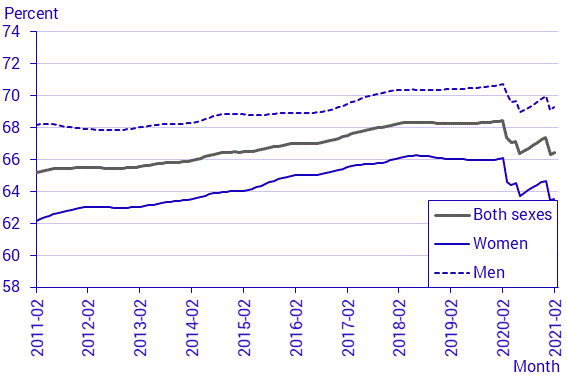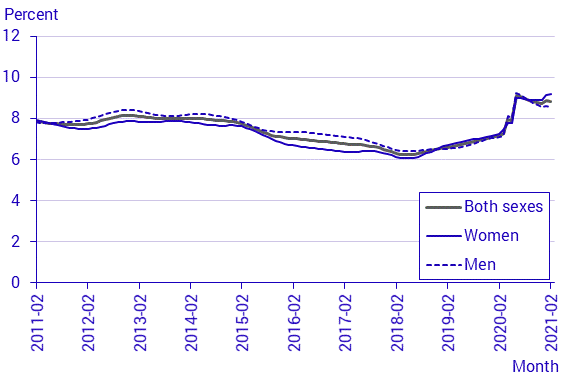Labour Force Surveys (LFS), February 2021 (corrected 2021-04-26)
Some light in a subdued labour market
Statistical news from Statistics Sweden 2021-03-18 9.30
As from 1 January 2021, the Swedish LFS has been amended to comply with the new EU framework regulation on social statistics, which has resulted in some changes in the survey. These changes currently lead to increased uncertainty, in particular for comparisons over time. In February 2021, 4 949 000 people were employed. There were 531 000 unemployed persons, which corresponds to an unemployment rate of 9.7 percent. The total average number of hours worked was 163.9 million hours per week. Seasonally adjusted and smoothed data showed that there were 4 992 000 employed persons in February. The unemployment rate was 8.8 percent.
Since 1 January, the Swedish LFS is in compliance with the new EU framework regulation on social statistics (Regulation (EU) 2019/1700 of the European Parliament and of the Council). This framework regulation has involved changes in the definition of employment, the sampling procedure, and the structure of the questionnaire. These changes have caused breaks in the time series and therefore, this item of statistical news does not include any comparisons with the previous year for non-seasonally adjusted data. Comparisons with the previous months in 2021 will be possible for seasonally adjusted and smoothed data. However, comparisons with the previous year are not advised, as it is currently not possible to distinguish real changes from the effect of adapting to the new framework regulation.
The number of employed persons decreased, partly due to the change in the definition, in which people who are completely absent from work for three months or more for certain reasons are no longer classified as being employed. Furthermore, new and updated information is used in the weighting procedures, which improves the precision in the estimates, although it also affects the levels of the number of employed persons. The change in the definition and the new weighting procedure led to a total estimated number of employed persons in February that is 100 000 fewer than according to the previous method.
Care should be taken when interpreting the outcome for February 2021, as non-response may have affected the level of the number of unemployed people and the unemployment rate.
More information on the alignment to the framework regulation is available on the LFS product page at Information on the introduction of the new 2021 framework regulation in the LFS (scb.se).
The labour force
In February 2021, there were 5 479 000 people aged 15–74 years in the labour force, not seasonally adjusted. The number of men in the labour force was 2 915 000 and there were 2 564 000 women in the labour force. The relative labour force participation rate was 72.9 percent. This rate was 69.5 percent for women and 76.3 percent for men.
According to seasonally adjusted and smoothed data, there were 5 476 000 people in the labour force and the labour force participation rate was 72.9 percent. Compared with January 2021, seasonally adjusted and smoothed data showed an increase in the number of people in the labour force as well as the labour force participation rate.
The outcome for the labour force may have been affected in part by the change in the definition of employed persons, and in part by the new information used in the weighting procedure.
Employment
In February 2021, there were 4 949 000 employed people aged 15–74 years, not seasonally adjusted. There were 2 301 000 employed women and 2 648 000 employed men. The employment rate was 65.9 percent. The rate was 62.3 percent for women, and 69.3 percent for men.
According to seasonally adjusted and smoothed data, there were 4 992 000 employed persons and the employment rate was 66.5 percent. Compared with January 2021, seasonally adjusted and smoothed data showed an increase in the number of employed persons as well as the employment rate.
The number of employed persons has been affected by the change in the definition, in which some people who were absent from work are no longer classified as being employed. The new information used in the weighting procedure has also affected the outcome.
Employees
In February 2021, there were 4 435 000 employees according to non-seasonally adjusted data. Among employees, there were 2 170 000 women and 2 266 000 men. There were 3 833 000 permanent employees and 602 000 temporary employees.
According to seasonally adjusted and smoothed data, there were 4 504 000 employees. There were 3 834 000 permanent employees and 670 000 temporary employees. Compared with January 2021, seasonally adjusted and smoothed data showed an increase in the number of employees.
Employees are a subset of employed persons, which have been affected by a change in the definition as well as the use of new information in the weighting procedure.
Hours worked
In February 2021, the average number of hours worked was 163.9 million per week, not seasonally adjusted.
Seasonally adjusted and smoothed data showed that the total average number of hours worked per week was 150.0 million, an increase compared with the previous month.
The number of hours may have been affected by the use of new information in the weighting procedure.
At work and absence
There were 4 525 000 people employed and at work in February 2021, not seasonally adjusted.
The LFS estimates the number of people who were absent from their principal occupation for the whole week or for part of the week by main reason for absence. In February 2021, this figure was 1 057 000, not seasonally adjusted. There were 432 000 people absent for the whole week in February 2021. Among these, 153 000 were absent due to illness, while 63 000 people were absent due to holidays.
People who are absent due to lack of work or lay-offs are often absent for only part of the week. There were 54 000 people in total absent for the whole week or part of the week due to lay-offs. There were 34 000 people who stated lack of work as their main reason for absence.
Seasonally adjusted and smoothed data showed that there were 4 252 000 people at work. Compared with January 2021 seasonally adjusted and smoothed data showed an increase in the number of people at work.
As there has been a change in the definition of employed persons, in which some people who were absent from work are no longer classified as being in employment, this may have affected the number of people at work.
Unemployment
In February 2021, there were 531 000 unemployed persons aged 15–74 years, which corresponds to an unemployment rate of 9.7 percent, not seasonally adjusted. There were 267 000 unemployed men, which corresponds to 9.2 percent, and 263 000 unemployed women, which corresponds to 10.3 percent.
In February, there were 484 000 unemployed persons according to seasonally adjusted and smoothed data, which corresponds to an unemployment rate of 8.8 percent.
Non-response in February 2021 may have affected the level of the number of unemployed persons and the unemployment rate, and the outcome should be interpreted with caution.
Additional questions on the impact of COVID-19 on the labour market (corrected 2021-04-26)
In view of the coronavirus (COVID-19) pandemic, questions about the impact of COVID-19 have been added to the LFS. The answers to these questions show that 75 000 employed people aged 15–74 years were absent during the whole reference week in February related to COVID-19. This means that among people who were absent during the entire reference week, 17.8 percent were absent due to COVID-19. This proportion was 17.7 percent for men and 17.8 percent for women.
Among employees aged 15–74 years who were absent during the entire reference week, 16.3 percent, which corresponds to 60 000 people, stated that their absence was related to COVID-19. Furthermore, 25.5 percent of employees who were absent during part of the week, 147 000 people, stated that their absence was related to COVID-19. Among self-employed persons and assisting family members aged 15–74 years, 37.2 percent felt that they had less work due to the coronavirus pandemic, while 19.3 percent felt that they had more work.
To be classified as unemployed in the LFS, a person must be without a job, must be able to start work and must have sought work. This means that people who are without a job, but who have not been seeking work or are unable to start work are not classified as unemployed, but are classified, instead, as not in the labour force. In February 2021, there were 2 033 000 people aged 15–74 years not in the labour force. Among these, 84 000 people stated that they would have been able to work, but had not sought work due to COVID-19.


Next publishing will be
2021-03-18 at 9:30.
Feel free to use the facts from this statistical news but remember to state Source: Statistics Sweden.
